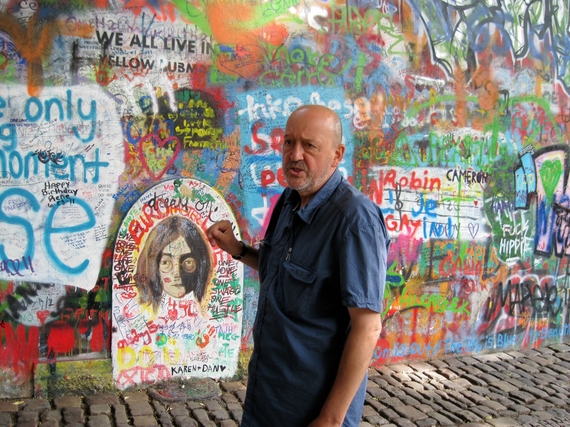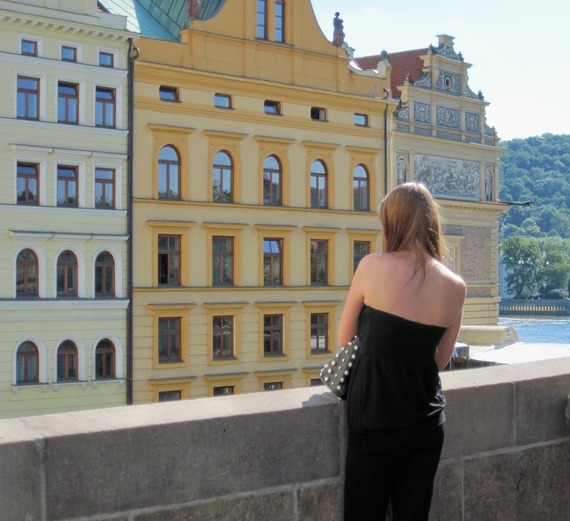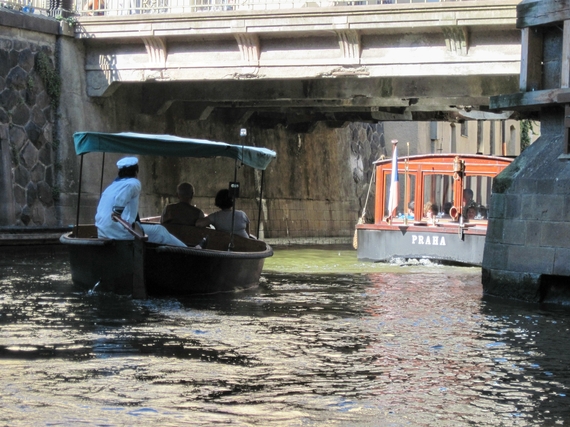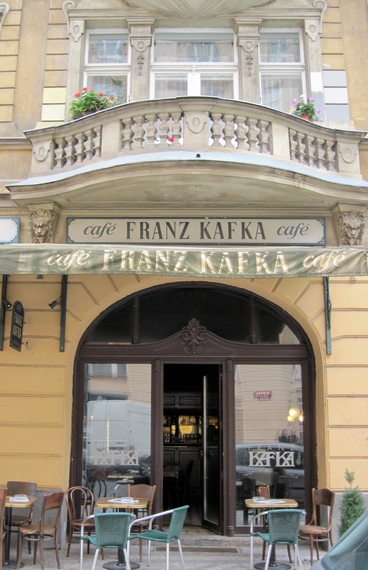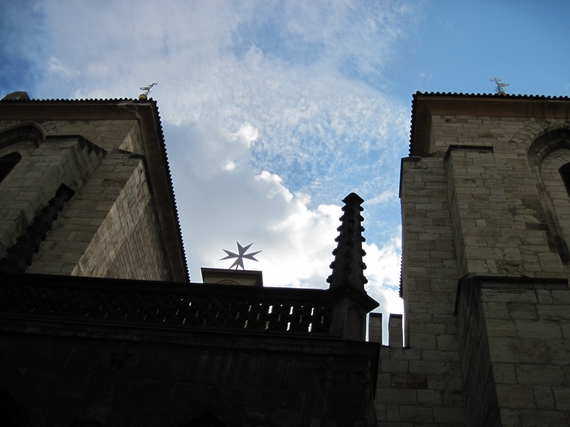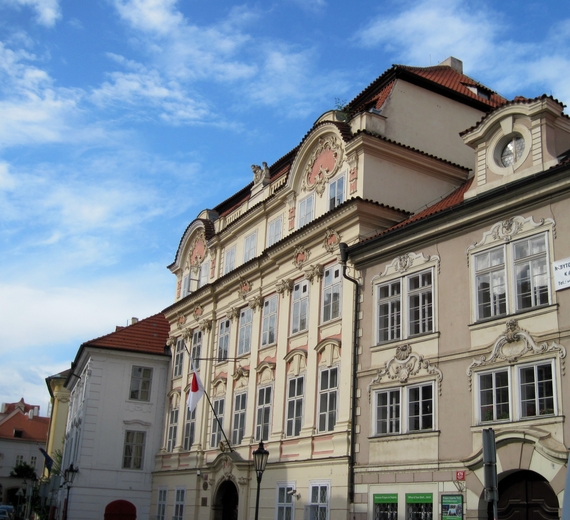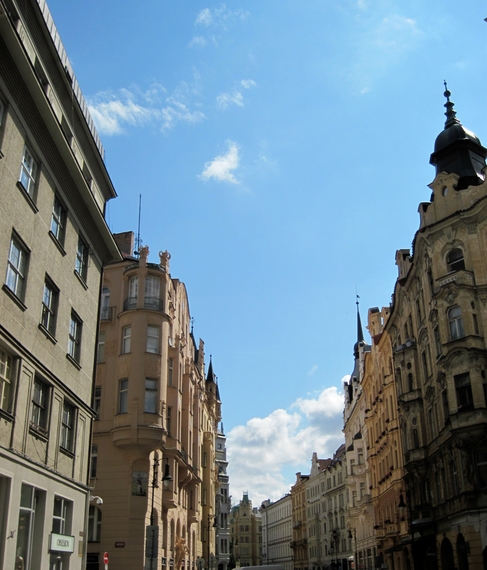If Prague were a planet, circling and spinning past the sun, it would be one that sends back light to those who take the time to look. A Mercury or Mars, let's say. Rich and purple and alert for steps upon its soil.
During my first trip here, in June, I feel like I have come by Saturn rocket, not by jet. Milling with the hourly crowd that waits below the Astronomical Clock on Staromestska Namesti (or Old Town Square) I quietly unzip my pack and leave my guidebook for another tourist, on a café chair. Books, like this, will get you to expect a city that is deeply northern, glowering with gray and serious stone. Berlin, I'd guessed, or Warsaw. Vienna with a twist.
What no one tells you is this: the Czech Republic's capital does not belong near Germany, Austria or Poland. With its delicately tiled sidewalks, its buildings of spring green and orange and blue, it should be close to some southern ocean. A Lisbon that loves Mozart. Or an Athens that forgot Sophocles and gave birth to Kafka instead.
Suddenly, the bells of the Astronomical Clock go off. Out pops its parade of clockwork icons and saints. The crowd lets out a yell. I cheer too.
In place of my guidebook I turn to Milos Curik, who runs a tour company called Arts & Music Travel. Curik gathers our group, waving arms like a conductor who has lost his baton, and we are off and into narrow streets.
"Prague is like an architectural quilt," he shouts, surging ahead. "One that's taken centuries to sew."
Some of the quiltwork reflects its country's checkered past. Once known as the Kingdom of Bohemia, Czechs have been incorporated in the Habsburg monarchy, merged into Czechoslovakia, and held under the yoke of Soviet-bloc communism before peacefully splitting off from Slovakia in 1993. In the Old Town, Gothic churches are squeezed in next to houses with Roman foundations which lead to buildings that are grandly Baroque. We lurch ahead and backwards in time by simply marching around.
Because of this background mix, Prague has been, for years, a draw for filmmakers from Hollywood and elsewhere. It's a city that can be anything a director wants. Classics like Miloš Forman's Amadeus (1984) and Philip Kaufman's The Unbearable Lightness of Being (1988) were draped over city exteriors, and Daniel Craig's James Bond ran around here alongside Judi Dench in the 2006 remake of Casino Royale.
As we tourists pass façade after facade, Milos Curik's thoughts and legs move fast. He is an Olympian guide, full of goals for the group. "I would like to show you all 16 of Franz Kafka's apartments in Prague!" he says. "But we do not have time!"
We settle for a visit to the house in which Kafka was born, near the Church of St. Nicholas in the Old Town. The house has a normal roof and normal walls. It doesn't make me think of Kafka. But somehow, reading a plaque about the author, I get a chill. I hear the slamming of a window. "Absurd, absurd," caws a crow right overhead. The Trial, I think, and In the Penal Colony: Books like these came out of here.
Kafka was of German-Jewish descent and our next stops are in Josefov, the city's Jewish quarter. Here is the Altneuschul which dates to 1275 and is the earliest synagogue in Europe that is still in use. In the vaulted interior I spot a banner with its Star of David, sewn in gold. It also depicts a hat, which makes me hunt for a brochure. According to this, it's yet another bit of history: a style often worn by Jews here in the 15th century.
Pinkasova Synagóga (or Pinkas Synagogue) is something more. Though simpler in design and smaller, it is a testament in curving stone. Its inside walls are a mass of tens of thousands of hand-painted names in minuscule print. "Czech Jews," explains Curik. "Victims of the Nazis during World War II."
Silent now, we follow our guide into a square called Ovocný Trh. Curik points out an enormous set of metal doors across from the Museum of Czech Cubism. When we look closely, we see that the doors are adorned with sculpted heads all staring in the same direction.
"When people ask me what communism was like," says Curik with a smirk, "I show them these."
"But what's behind the doors?" asks someone.
"Garbage," says Curik. "Much like the economic system."
Later, on a walk by myself, I come back here to the square and go into the museum. My artist grandfather had always taught me to think of Cubism in terms of painting. But in the former Czechoslovakia, the movement launched itself into architecture and design.
Since the Czech Cubism exhibits are inside Josef Gočár's "House of the Black Madonna" (1911), the city's first cubist structure, I get a feel for what this meant by just examining the building's blocks and angles outside. Its black iron balcony is full of rectangles, not bars. Bay windows do not sweep or curve: they cluster like squared-off panes around a lighthouse's torch.
Back on the tour, we reach a different side of Prague. One that's loud and maniacal after what we've seen so far. What is it? says someone.
"Look," says Curik simply. "Look at the Lennon Wall."
There are slashes of electric pink and blue. Lyrics in English, Beatles lyrics, and a face staring out of the frenetic scrawl. A street-artist's portrait of John Lennon that, according to Curik, was painted here soon after his death.
Since the 1980s, this slab of concrete on Velkopřevorské náměstí has served as a message board, a canvas for social commentary, and spray-painted sketches that take after 1960s artists like Peter Max. Criticisms here would sometimes stick in the craw of the former communist regime, leading to clashes between students and security police.
"But like Wikipedia," sighs Curik, "it is always changing, always being painted over, year after year."
Here comes the Sun, I read.
Sun, sun, sun.
Here it comes.
There's a part of me that wants to add more.
I don't. I'm confident that Prague can write on its wall without me. Early Doors and Cream cuts have been wafting from stores. Czechs are up on their classic rock: I know this to be true. And as I discover, Curik is an aficionado, a former concert promoter.
"Did you know," he tells us softly, as if secret police might still be listening, "that Frank Zappa was an advisor to our former president Václav Havel?"
I am sure that Curik must be joking, but when I check this later I find, amazingly, that it is true. Zappa and Kafka. Kafka and Zappa. There must be a connection, I think. Then it hits me.
I remember the caw of that crow: "Absurd, absurd."
Prague may be a bit absurd, I think. But this is its ancient and successful plan. Few northern cities are this light, this warm. Few capitals choose history over heavy progress. And no place on Earth can show you centuries of style--both harmony and art--inside an afternoon.
The rocket I came in on is billowing smoke. I'm running late. It blasts its horn.
I look to the sky, but stars and planets are erased. I see only cubist angles, a synagogue, a wall. The music of other spheres can wait, I think. Notes and chords surround me in the Old Town Square.
I hasten to the clock. The bells, the circling saints. The crowd that is about to cheer.
Night is falling over Prague. And I am rooted, watching it come.
What I want is here.
Peter Mandel is the author of the read-aloud bestseller Jackhammer Sam (Macmillan/Roaring Brook) and other books for kids, including Zoo Ah-Choooo (Holiday House) and Bun, Onion, Burger (Simon & Schuster).
